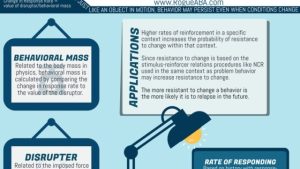Applied Behavior Analysis (ABA) is a field of study that delves into understanding how behavior is shaped and modified through systematic observation, measurement, and intervention. With its roots in the science of behaviorism, ABA has become widely recognized as an effective therapy for individuals of all ages, particularly those with autism spectrum disorder (ASD) or other developmental disabilities. Through the application of well-established principles and techniques, ABA therapists work with individuals to tackle a wide range of behavioral challenges, aiming to enhance their daily functioning and overall quality of life. By meticulously analyzing and manipulating observable behaviors, ABA holds the key to unlocking potential and fostering positive, lasting changes.
Understanding ABA Therapy
Applied Behavior Analysis (ABA) therapy is a scientifically validated approach that focuses on understanding and changing human behavior. It is based on the principles of behaviorism and uses a systematic approach to analyze and modify behaviors that are socially significant. ABA therapy is widely recognized as an effective treatment for individuals with autism spectrum disorder (ASD), but it can also be applied to address a variety of other behavioral issues.
The main goal of ABA therapy is to help individuals develop new skills and behaviors, while reducing unwanted behaviors. It involves assessing and identifying specific target behaviors and then implementing interventions to promote positive changes. ABA approaches are tailored to the unique needs of each individual, making it a highly customizable and flexible therapy.
One of the key components of ABA therapy is the use of reinforcement strategies. Positive reinforcement is used to increase desired behaviors by providing rewards or praise whenever they occur. This helps to strengthen the connection between the behavior and the positive outcome, making it more likely to recur in the future. On the other hand, unwanted behaviors are addressed through the use of strategies such as extinction, which involves withholding reinforcement for those behaviors, and implementing replacement behaviors that serve the same function.
ABA therapy for school behavior
ABA therapy also focuses on teaching functional skills that are essential for everyday life. This can include communication skills, social interaction, self-care, and academic skills, among others. The therapy sessions typically involve breaking down these skills into smaller, manageable steps and using systematic teaching techniques to help individuals learn and generalize these skills across different settings.
In conclusion, ABA therapy is an evidence-based approach that aims to promote positive behaviors while reducing problematic ones. It provides individuals with the skills they need to live more independent and fulfilling lives. By understanding the principles and strategies of ABA therapy, professionals, caregivers, and individuals themselves can effectively work towards behavior change and improvement.
Key Principles of Applied Behavior Analysis
Applied Behavior Analysis (ABA) is a scientific approach that focuses on understanding and modifying behavior. ABA therapy utilizes specific principles to shape behavior in meaningful and effective ways. Let’s explore three key principles of Applied Behavior Analysis.
The first principle of ABA is positive reinforcement. This involves providing rewards or incentives to increase the likelihood of desired behavior. By identifying and delivering positive consequences, individuals are encouraged to engage in behavior that is beneficial or helpful. For example, a child may be given a sticker or praise for completing their homework, which reinforces the behavior of completing assignments promptly.
The second principle is prompt and fading. This involves providing guidance or cues to assist individuals in performing a specific behavior, gradually reducing assistance over time. By initially using prompts that help individuals understand what is expected, and then gradually fading those prompts, the goal is to facilitate independent behavior. For instance, a teacher may initially demonstrate how to tie shoelaces and then gradually reduce the amount of assistance until the child can tie their shoes independently.
The third principle is behavior shaping through successive approximations. This principle involves breaking down complex behaviors into smaller, manageable steps to make learning more achievable. By systematically reinforcing each successive approximation towards the desired behavior, individuals can gradually acquire new skills. For instance, when teaching a child to ride a bicycle, they begin by learning to balance, then pedal, and eventually master the skill of riding independently.
These key principles of Applied Behavior Analysis provide a framework for understanding how behavior can be shaped and modified effectively. By using positive reinforcement, prompt and fading techniques, and behavior shaping through successive approximations, ABA therapy aims to promote positive changes in behavior and improve overall quality of life.

Applications of ABA in Behavior Modification
Applied Behavior Analysis, commonly known as ABA therapy, is a scientific approach that has been widely used in behavior modification. Its principles and methods have proven to be effective in various areas of human behavior. This section highlights three key applications of ABA in behavior modification.
Autism Spectrum Disorder (ASD): ABA therapy has gained significant recognition for its positive impact on individuals with Autism Spectrum Disorder. By implementing systematic behavioral interventions, ABA aims to increase adaptive behaviors while reducing challenging behaviors. It focuses on teaching essential skills such as communication, social interaction, and self-care. ABA therapists work closely with individuals with ASD, creating personalized programs that target specific areas of improvement, thereby promoting overall development and enhancing the quality of life.
Education and Classroom Management: ABA techniques have been widely adopted in educational settings to support students with diverse learning needs. Through the use of positive reinforcement, shaping, and prompting, ABA interventions effectively address behavioral challenges within classrooms. Teachers and educators use ABA strategies to shape desired behaviors, foster academic engagement, and ensure a structured and supportive learning environment for all students.
Parenting and Home-Based Interventions: ABA also holds immense value in promoting positive behavior within family dynamics. By employing behavior modification techniques, parents can utilize ABA principles to reinforce appropriate behavior and discourage unwanted behaviors. ABA intervention at home focuses on establishing effective communication, promoting daily routines, and fostering independence in children. Parent training programs that incorporate ABA techniques provide parents with the necessary skills and knowledge to manage challenging behaviors and enhance the overall parent-child relationship.
In conclusion, the applications of Applied Behavior Analysis are vast and extend beyond the three mentioned areas. ABA therapy has demonstrated its effectiveness in behavior modification, making it a valuable tool in various settings where behavior change is desired. Through systematic approaches, individualized interventions, and a focus on positive reinforcement, ABA continues to contribute significantly to improving the lives of individuals and families.






Recent Comments